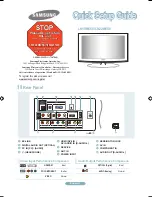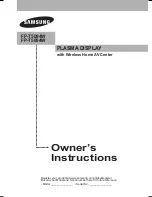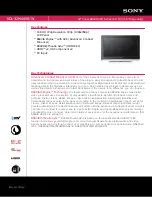
LIMITED WARRANTY
INOR Process AB, or any other affiliated company within the Inor Group (hereinafter jointly
referred to as ”Inor”), hereby warrants that the Product will be free from defects in materials or
workmanship for a period of five (5) years from the date of delivery (”Limited Warranty”). This
Limited Warranty is limited to repair or replacement at Inor’s option and is effective only for the first
end-user of the Product. Upon receipt of a warranty claim, Inor shall respond within a reasonable
time period as to its decision concerning:
1 Whether Inor acknowledges its responsibility for any asserted defect in
materials or workmanship; and, if so,
2 the appropriate cause of action to be taken (i.e. whether a defective
product should be replaced or repaired by Inor).
This Limited Warranty applies only if the Product:
1 is installed according to the instructions furnished by Inor;
2 is connected to a proper power supply;
3 is not misused or abused; and
4 there is no evidence of tampering, mishandling, neglect, accidental damage, modification
or repair without the approval of Inor or damage done to the Product by anyone other
than Inor.
This Limited Warranty is provided by Inor and contains the only express warranty provided.
INOR SPECIFICALLY DISCLAIMS ANY EXPRESS WARRANTY NOT PROVIDED HEREIN AND
ANY IMPLIED WARRANTY, GUARANTEE OR REPRESENTATION AS TO SUITABILITY FOR
ANY PARTICULAR PURPOSE, PERFORMANCE, QUALITY AND ABSENCE OF ANY HIDDEN
DEFECTS, AND ANY REMEDY FOR BREACH OF CONTRACT, WHICH BUT FOR THIS PROVI-
SION, MIGHT ARISE BY IMPLICATION, OPERATION OF LAW, CUSTOM OF TRADE OR COURSE
OF DEALING, INCLUDING IMPLIED WARRANTIES OF MERCHANTABILITY
AND FITNESS FOR A PARTICULAR PURPOSE. EXCEPT AS PROVIDED HEREIN,
INOR FURTHER DISCLAIMS ANY RESPONSIBILITY FOR LOSSES, EXPENSES,
INCONVENIENCES, SPECIAL, DIRECT, SECONDARY OR CONSEQUENTIAL
DAMAGES ARISING FROM OWNERSHIP OR USE OF THE PRODUCT.
Products that are covered by the Limited Warranty will either be repaired or replaced at the option
of Inor. Customer pays freight to Inor, and Inor will pay the return freight by post or other “normal”
way of transport. If any other type of return freight is requested, customer pays the whole return
cost.
MOUNTING/DIMENSIONS CONNECTION HEAD
Programming:
The programming is executed through 3 keys
mounted on the bottom of the display. The central key is the
Enter (
F
) key. The lateral keys act as the up
S
and down
T
digit; they also act as selection of the parameters.
!
CONFIGURATION
Key
Function
F
Access to the programming; move to the following parameter menu;
saving of data and close of the programming
T
Decreasing digit; selection/set-up of a parameter
S
Increasing digit; selection/set-up of a parameter
S
+
T
“Escape”
Operation:
Press the key
F
for more than 3 seconds to get access to the
programming procedure. The display will visualize the “
dP
” function, which is the
first programming section:
D
ecimal
P
oint. By pressing the
S
(increase) and
T
(decrease) keys it’s possible to scroll all the other programming windows. At
the end of the programming phase the modified parameters are stored auto-
matically and retained also during the switch off of the instrument.
Programming procedure:
Set-up of the decimal point (dP)
Press the
S
or
T
keys to select the decimal point position (from zero to 3
decimals). Press
F
to confirm. Default = 1 decimal
Set-up of the engineering value related to the zero point (ZErO)
Press the
S
or
T
keys to select the engineering value zero (-1999 to
9999). Press
F
to confirm. Default = 0.0
Set-up of the engineering value related to the span range (SPAn)
Press the
S
or
T
keys to select the engineering range value (-1999
+9999). Press
F
to confirm. Default = 100.0
Set-up of the limit on the input current (Li)
This parameter allows to
select the over-load limit of the visualization.
If Li = 0, when the current overcomes the 20 mA value, the display will indi-
cate the
O
ver
L
oad message
OL
(
-OL
when the current is lower that 4 mA).
If Li = 1, the visualization will be extended of a 10% over the 4...20 mA
range, before indicating the overload. In both cases, overcoming the
display maximum readings (-1999 +9999), the overload message will be
indicated. Default = 1
Set-up of the filter (FiLt)
When the 4...20 mA is disturbed it is possible
to select an higher value of FiLt in order to get a more stable and clear
visualization on the display.
Press the key
S
to increase the filter value on the input and the key
T
to
decrease the filter value.
It’s possible to set-up different values from 1 to 8; when FiLt = 1 no filter
is applied on the input and the digital reading occurs every 250 ms.
In this case the updating period of the display will be 250 ms multiplied by
the FiLt value. Example: if FiLt = 5 the updating period of the display will
be 1.25 s. Default = 2
Set-up of resolution (riS)
This function allows to set-up the resolution
of the display; when riS = 1 the display will indicate all the available digit in
the scale, within the programmed range.
When riS = 2 the steps between two consecutive readings will be doubled:
with riS = 2 it will not be possible to indicate odd numbers.
Selectable values for riS are: 1, 2, 5 and 10.
It is suggested to increase the resolution only if the set range is very large
(example 10000 points) and/or if the 4...20 mA signal is quite unstable: on
the contrary the maximum resolution is normally used. Default = 1
Summary
Key
Function
Disply
SCROLL
Set-up of the decimal point
DP / 000.0
S
or
T
Set-up of the engineering value ZERO ZErO / 0.0
Set-up of the engineering range SPAN SPAn / 100.0
Set-up of the OverLoad Limit
Li / 0
Set-up of the input Filter
FiLT / 1
Set-up of the Resolution
riS / 1
F
Access to enter the programming window. Allow to exit the
programmimg window and to save the modifications.
S
Increasing digit
0 to 9
T
Decreasing digit
9 to 0
S
+
T
Exit the programmimg without saving
CALIBRATION
By pressing contemporary the
S
+
T
keys for more than 3 s, it is possible
to access to the calibrating function where it is possible to calibrate the
zero and the full scale of the A/D converter of the digital indicator.
Entering this procedure and modifying the parameters will change
the factory calibration data. This function must be executed by
specialised personnel only by using adequate instrumentation. A wrong
calibration will affect the right functionality of the instrument itself.
Step 1: Zero-point calibration
Inside the calibration window, select the ZERO point calibration
(C4)
by
pressing
S
or
T
keys. Apply a 4 mA current to the instrument, wait for the
stabilization of the signal and of the indication and press the key
F
until the
indication
CAL
will appear on the display. After few seconds, the new
engineering ZERO value will be indicated.
Exit the Zero-point calibration by pressing
S
+
T
keys together and pro-
ceed with the Full Scale calibration.
Step 2: Full scale calibration
Inside the calibration window, select the Full Scale calibration
(C20)
by
pressing
S
or
T
keys. Apply a 20 mA current to the instrument and pro-
ceed as for the Zero-point calibration.
Window
(polycarbonate)
LCD-H20
Mounting kit
KDST1




















